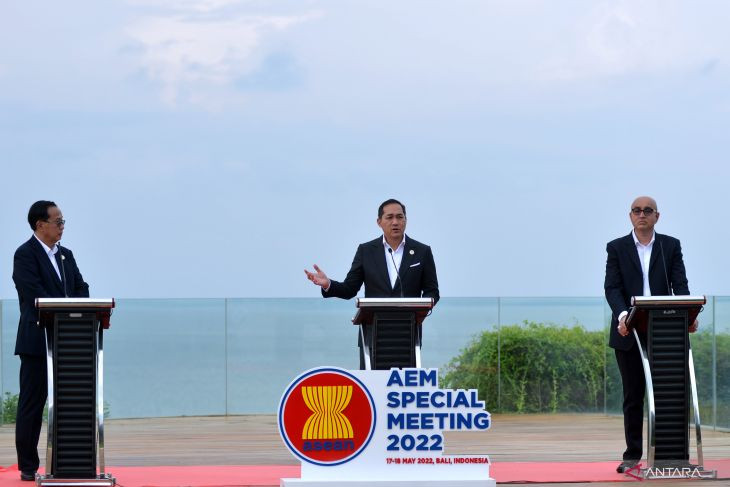Just over a year ago, ASEAN released its mid-term review of the ASEAN Economic Community (AEC) Blueprint 2025. The review reported that 54.1 percent o
Just over a year ago, ASEAN released its mid-term review of the ASEAN Economic Community (AEC) Blueprint 2025. The review reported that 54.1 percent of the document’s line items had been completed, with another 34.2 percent in progress. The grouping was lauded for having made “notable advancements” towards economic integration, though it also encouraged to “accelerate [its] pace of implementation”. Reading the review in May 2022, this observation appears more like a warning. Amidst geopolitical competition between the United States and China, the economic fallout from COVID-19 and the Russian invasion of Ukraine, some observers have claimed that the post-1990s era of globalization is over. Global share of trade to gross domestic product, a key metric to measure global integration, has been in steady decline since 2008, and might well continue to drop. The extent and nature of this deglobalization remain to be seen. Nonetheless, ASEAN can leverage its internal economic potential to weather this storm. Regional policymakers have long recognized the potential of the region’s market, and ongoing plans such as the ASEAN Comprehensive Recovery Framework seek to capitalize on intra-regional economic activity. The inconvenient truth, however, is that the grouping’s normal policymaking methods could hinder such aspirations. ASEAN’s network of loosely-prioritized policies creates a cumbersome policy landscape that arguably promotes discussion over action. For ASEAN to emerge stronger from this turbulence, it must move more quickly and boldly to harness its potential. For ASEAN, deglobalization is neither a new nor wholly negative issue. Member states such as Vietnam benefitted from manufacturing relocation spurred by the US-China trade war, and will continue to implement internal policies to leverage future opportunities. However, deglobalization still poses a threat to ASEAN as a region due to its implications for supply chains. There is thus a growing need for ASEAN to support intra-regional trade as an insurance plan, upgrading trade mechanisms such as the ASEAN Single Window and the ASEAN Trade in Goods Agreement (ATIGA) while furthering efforts to support the digital economy. ASEAN’s typical approach to such challenges is paved with policy documents. Ministerial meetings endorse broad themes in overarching documents such as the Digital Integration Framework Action Plan (DIFAP). Subsequent meetings at the ministerial and senior official levels produce masterplans and strategies to provide more concrete implementation plans. Intermittent roadmaps, such as the Bandar Seri Begawan Roadmap on Digital Transformation (BSBR), identify key initiatives to be expedited. In theory, this suggests an intricately crafted policy landscape. In practice, however, things are messier. First, there is a tendency for ASEAN strategy documents to paint in broad strokes and not specify the relative importance of their themes. This lack of prioritization can result in documents that read more like laundry lists than coherent strategies. As noted in the ASEAN Digital Masterplan 2025 (ADM 2025), for example, such a “spray gun approach” adopted by earlier documents dissipated the attention and energy of policymakers. Second, ASEAN strategies tend to focus on low-hanging fruit such as studies. Further action, like complicated reforms, is often eschewed or delayed indefinitely. Granted, ASEAN’s intergovernmental nature precludes it from calling for drastic policy changes, and it is necessary to establish baseline understandings among policymakers. Yet such efforts occupy too significant a portion of ASEAN’s efforts. As the mid-term review on the AEC Blueprint observes, ASEAN needs to focus less on studies and more on tangible policy reforms. Recent documents such as the BSBR have included prioritized implementation timelines and bigger ambitions, including a comprehensive ASEAN Digital Economy Framework Agreement. However, this raises a third issue: willpower. The mid-term review criticized the uneven implementation of the AEC blueprint, with “easier” initiatives prioritized over challenging commitments such as addressing non-tariff measures. Better practices must be enshrined in both policy and practice. ASEAN’s organizational structure, which emphasizes consensus and conversation, limits how quickly it can make policies. Nonetheless, this can be addressed by moderating ASEAN’s expectations. For example, policymakers could ease implementation by utilizing sub-national policy sandboxes, which are already part of the ASEAN Smart Cities Network. With a smaller scale of implementation, such an approach could offer a useful confidence and expertise-building exercise for policymakers as they build up towards more ambitious efforts. In the longer-term, ASEAN must update core policy documents to reflect emerging issues. When ATIGA was signed in 2010, the digital economy was barely on the policy radar. Now, as an important growth engine, it is increasingly necessary to include digital issues in the agreement. Ideally, this inclusion should involve a special chapter for digital trade, in line with the Digital Economic Partnership Agreement between Singapore, New Zealand and Chile. ASEAN’s emphasis on consensus makes a few lines on the importance of the digital economy a more likely outcome, with an open door for future annexes to address digitalization. Still, ASEAN should resist the urge to kick the can down the road. While regional integration remains a work in progress, some ASEAN members have already signed trade agreements with digital economy chapters, most notably the Comprehensive and Progressive Trans-Pacific Partnership. A gold standard for action is already present – what remains is for ASEAN policymakers to recognize it. ASEAN may yet shield its member states against the alarming trend of deglobalization, but it must find the drive to pursue regionalism with renewed force.
Fonte: Thejakartapost.com

